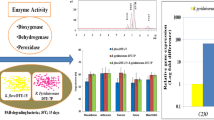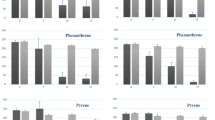Abstract
Screening of high-efficient polycyclic aromatic hydrocarbon (PAH)-degrading bacteria is important due to environmental contamination by PAHs. In this study, sediment contaminated with phenanthrene (Phe), pyrene (Pyr), and fluoranthene (Fluo) was used as a source of bacteria. The ability of these isolated bacteria to convert PAHs into valuable products was determined. Based on a primary screening, 20 bacterial isolates were obtained; however, only three strains showed a good PAH-degrading ability, and were identified as Pseudomonas aeruginosa, Pseudomonas sp., and Ralstonia sp. PAH-degrading genes were detected in all isolates. Notably, all selected strains could degrade PAHs using the ortho or meta cleavage pathways due to the presence of catechol dioxygenase genes. The ability of isolated strains to convert PAHs into polyhydroxyalkanoate (PHA) was also evaluated in both single and mixed cultures. Single cultures of P. aeruginosa PAH-P02 showed 100% degradation of PAHs, with the highest biomass (1.27 ± 0.02 g l−1) and PHA content (38.20 ± 1.92% dry cell weight). However, degradative ability and PHA production were decreased when mixtures of PAHs were used. This study showed that P. aeruginosa, Pseudomonas sp., and Ralstonia sp. were able to degrade PAHs and convert them into medium-chain-length (mcl)-PHA. A high content of 3-hydroxydecanoate (3HD, C10) was observed in this study. The formation of mcl-PHA with high 3HD content from Pyr and Fluo, and the assessment of mixed cultures converting PAHs to mcl-PHA, were novel contributions.





Similar content being viewed by others
References
Narancic T, Kenny ST, Djokic L, Vasiljevic B, O’Connor KE, Nikodinovic-Runic J (2012) Medium-chain-length polyhydroxyalkanoate production by newly isolated Pseudomonas sp. TN301 from a wide range of polyaromatic and monoaromatic hydrocarbons. J Appl Microbiol 113:508–520. https://doi.org/10.1111/j.1365-2672.2012.05353.x
Qi YB, Wang CY, Lv CY, Lun ZM, Zheng CG (2017) Removal capacities of polycyclic aromatic hydrocarbons (PAHs) by a newly isolated strain from oilfield produced water. Int J Environ Res Public Health 14:215. https://doi.org/10.3390/ijerph14020215
Dong DM, Liu XX, Hua XY, Guo ZY, Li LF, Zhang LW, Xie YJ (2016) Sedimentary record of polycyclic aromatic hydrocarbons in Songhua River, China. Environ Earth Sci 75:508–515. https://doi.org/10.1007/s12665-015-5123-y
Schneider IL, Teixeira EC, Agudelo-Castaneda DM, e Silva GS, Balzaretti N, Braga MF, Oliveira LFS (2016) FTIR analysis and evaluation of carcinogenic and mutagenic risks of nitro-polycyclic aromatic hydrocarbons in PM1.0. Sci Total Environ 541:1151–1160. https://doi.org/10.1016/j.scitotenv.2015.09.142
Boonyatumanond R, Wattayakorn G, Togo A, Takada H (2006) Distribution and origins of polycyclic aromatic hydrocarbons (PAHs) in riverine, estuarine, and marine sediments in Thailand. Mar Pollut Bull 52:942–956. https://doi.org/10.1016/j.marpolbul.2005.12.015
Alegbeleye OO, Opeolu BO, Jackson V (2017) Bioremediation of polycyclic aromatic hydrocarbon (PAH) compounds: (acenaphthene and fluorene) in water using indigenous bacterial species isolated from the Diep and Plankenburg rivers, Western Cape, South Africa. Braz J Microbiol 48:314–325. https://doi.org/10.1016/j.bjm.2016.07.027
Habe H, Omori T (2003) Genetics of polycyclic aromatic hydrocarbon metabolism in diverse aerobic bacteria. Biosci Biotechnol Biochem 67:225–243. https://doi.org/10.1271/bbb.67.225
Zhao B, Wang H, Mao X, Li R (2009) A rapid screening method for bacteria degrading polycyclic aromatic hydrocarbons. Lett Appl Microbiol 49:408–410. https://doi.org/10.1111/j.1472-765X.2009.02668.x
Maiti A, Das S, Bhattacharyya N (2013) High gelatinase activity of a newly isolated polycyclic aromatic hydrocarbon degrading bacteria Bacillus weihenstephanensis strain AN1. J Pharm Res 6:199–204. https://doi.org/10.1016/j.jopr.2012.11.041
Fu B, Li QX, Xu T, Cui ZL, Sun Y, Li J (2014) Sphingobium sp. FB3 degrades a mixture of polycyclic aromatic hydrocarbons. Int Biodeterior Biodegrad 87:44–51. https://doi.org/10.1016/j.ibiod.2013.10.024
Liu SH, Zeng GM, Niu QY, Liu Y, Zhou L, Jiang LH, Tan XF, Xu P, Zhang C, Cheng M (2017) Bioremediation mechanisms of combined pollution of PAHs and heavy metals by bacteria and fungi: a mini review. Bioresource Technol 224:25–33. https://doi.org/10.1016/j.biortech.2016.11.095
Nikodinovic J, Kenny ST, Babu RP, Woods T, Blau WJ, O’ Connor KE (2008) The conversion of BTEX compounds by single and defined mixed cultures to medium-chain-length polyhydroxyalkanoate. Appl Microbiol Biotechnol 80:665–673. https://doi.org/10.1007/s00253-008-1593-0
Ward PG, de Roo G, O’Connor KE (2005) Accumulation of polyhydroxyalkanoate from styrene and phenylacetic acid by Pseudomonas putida CA-3. Appl Environ Microbiol 71:2046–2052. https://doi.org/10.1128/AEM.71.4.2046-2052.2005
Liang Q, Lloyd-Jones G (2011) Formation of poly-β-hydroxybutyrate from polycyclic aromatic hydrocarbons by Sphingobium scionense sp. WP01. 2011 International Conference on Computer Distributed Control and Intelligent Environmental Monitoring, Changsha, China. pp 2448–2451. https://doi.org/10.1109/CDCIEM.2011.120
Ward PG, O’Connor KE (2005) Bacterial synthesis of polyhydroxyalkanoates containing aromatic and aliphatic monomers by Pseudomonas putida CA-3. Int J Biol Macromol 35:127–133. https://doi.org/10.1016/j.ijbiomac.2005.01.001
Deelaman W (2009) Distribution of polycyclic aromatic hydrocarbons (PAHs) in sediment from Outer Songkhla Lake, Songkhla Province, and Ao Tap Lamu, Phang-nga Province. Thesis for Master of Science in Environmental Management, Prince of Songkla University (in Thai).
Dong CD, Chen CF, Chen CW (2012) Determination of polycyclic aromatic hydrocarbons in industrial harbor sediments by GC-MS. Int J Environ Res Public Health 9:2175–2188. https://doi.org/10.3390/ijerph9062175
Haleyur N, Shahsavari E, Taha M, Khudur LS, Koshlaf E, Osborn AM, Ball AS (2018) Assessing the degradation efficacy of native PAH-degrading bacteria from aged, weathered soils in an Australian former gasworks site. Geoderma 321:110–117. https://doi.org/10.1016/j.geoderma.2018.02.004
Sei K, Asano K, Tateishi N, Mori K, Ike M, Fujita M (1999) Design of PCR primers and gene probes for the general detection of bacterial populations capable of degrading aromatic compounds via catechol cleavage pathways. J Biosci Bioeng 88:542–550. https://doi.org/10.1016/s1389-1723(00)87673-2
Laurie AD, Lloyd-Jones G (2000) Quantification of phnAc and nahAc in contaminated New Zealand soils by competitive PCR. Appl Environ Microbiol 66:1814–1817. https://doi.org/10.1128/aem.66.5.1814-1817.2000
Kloos K, Munch JC, Schloter M (2006) A new method for the detection of alkane-monooxygenase homologous genes (alkB) in soils based on PCR-hybridization. J Microbiol Methods 66:486–496. https://doi.org/10.1016/j.mimet.2006.01.014
Powell SM, Ferguson SH, Bowman JP, Snape I (2006) Using real-time PCR to assess changes in the hydrocarbon-degrading microbial community in Antarctic soil during bioremediation. Microb Ecol 52:523–532. https://doi.org/10.1007/s00248-006-9131-z
Cébron A, Norini M, Beguiristain T, Leyval C (2008) Real-time PCR quantification of PAH-ring hydroxylating dioxygenase (PAH-RHDα) genes from Gram positive and Gram negative bacteria in soil and sediment samples. J Microbiol Methods 73:148–159. https://doi.org/10.1016/j.mimet.2008.01.009
Erdogmuş SF, Mutlu B, Korcan SE, Güven K, Konuk M (2013) Aromatic hydrocarbon degradation by halophilic archaea isolated from Camalti Saltern, Turkey. Water Air Soil Pollut 224:1449–1457. https://doi.org/10.1007/s11270-013-1449-9
Bradford MM (1976) A rapid and sensitive method for the quantitation of microorganism quantities of protein utilizing the principle of protein-dye binding. Anal Biochem 72:248–254. https://doi.org/10.1016/abio.1976.9999
Obayori OS, Ilori MO, Adebusoye SA, Oyetibo GO, Amund OO (2008) Pyrene-degradation potentials of Pseudomonas sp. isolated from polluted tropical soils. World J Microbiol Biotechnol 24:2639–2646. https://doi.org/10.1007/s11274-008-9790-7
Hegeman GD (1966) Synthesis of the enzymes of the mandelate pathway by Pseudomonas putida I. Synthesis of enzymes by the wild type. J Bacteriol 91:1140–1154
Spiekermann P, Rehm BH, Kalscheuer R, Baumeister D, Steinbuchel A (1999) A sensitive, viable-colony staining method using Nile red for direct screening of bacteria that accumulate polyhydroxyalkanoic acids and other lipid storage compounds. Ach Microbiol 171:73–80. https://doi.org/10.1007/s002030050681
Riis V, Mai W (1988) Gas chromatographic determination of poly-β-hydroxybutyric acid in microbial biomass after hydrochloric acid propanolysis. J Chromatogr 445:285–289. https://doi.org/10.1016/S0021-9673(01)84535-0
Zhang H, Sun L, Sun T, Li H, Luo Q (2013) Spatial distribution and seasonal variation of polycyclic aromatic hydrocarbons (PAHs) contaminations in surface water from the Hun River, Northeast China. Environ Monit Assess 185:1451–1462. https://doi.org/10.1007/s10661-012-2644-7
Zhu X, Ni X, Waigi MG, Liu J, Sun K, Gao Y (2016) Biodegradation of mixed PAHs by PAH-degrading endophytic bacteria. Int J Environ Res Public Health 13:805. https://doi.org/10.3390/ijerph13080805
Moharikar A, Kapley A, Purohit HJ (2003) Detection of dioxygenase genes present in various activated sludge. Environ Sci Pollut Res 10:373–378. https://doi.org/10.1065/espr2003.07.164
Sei K, Inoue D, Wada K (2004) Monitoring behavior of catabolic genes and change of microbial community structures in seawater microcosms during aromatic compound degradation. Water Res 38:4405–4414. https://doi.org/10.1016/j.watres.2004.08.028
Samanta SK, Singh OV, Jain RK (2002) Polycyclic aromatic hydrocarbons: environmental pollution and bioremediation. Trends Biotechnol 20:243–248. https://doi.org/10.1016/S0167-7799(02)01943-1
Cébron A, Louvel B, Faure P, France-Lanord C, Chen Y, Murrell JC, Leyyal C (2011) Root exudates modify bacterial diversity of phenanthrene degraders in PAH-polluted soil but not phenanthrene degradation rates. Environ Microbiol 13:722–736. https://doi.org/10.1111/j.1462-2920.2010.02376.x
Thomas F, Lorgeoux C, Faure P, Billet D, Cébron A (2016) Isolation and substrate screening of polycyclic aromatic hydrocarbon degrading bacteria from soil with long history of contamination. Int Biodeterior Bioderad 107:1–9. https://doi.org/10.1016/j.ibiod.2015.11.004
Bacosa HP, Inoue C (2015) Polycyclic aromatic hydrocarbons (PAHs) biodegradation potential and diversity of microbial consortia enriched from tsunami sediments in Miyagi. J Hazard Mater 283:689–697. https://doi.org/10.1016/j.jhazmert.2014.09.068
Ma J, Xu L, Jia LY (2013) Characterization of pyrene degradation by Pseudomonas sp. strain Jpyr-1 isolated from active sewage sludge. Bioresour Technol 140:15–21. https://doi.org/10.1016/j.biortech.2013.03.184
Zhong Y, Zou SC, Lin L, Luan TG, Qiu RL, Tam NFY (2010) Effects of pyrene and fluoranthene on the degradation characteristics of phenanthrene in the cometabolism process by Sphingomonas sp. strain PheB4 isolated from mangrove sediments. Mar Pollut Bull 60:2043–2049. https://doi.org/10.1016/j.marpolbul.2010.07.017
Di Martino C, Catone M, Lopez N, Raiger Iustman L (2014) Polyhydroxyalkanoate synthesis affects biosurfactant production and cell attachment to hydrocarbons in Pseudomonas sp. KA-08. Curr Microbiol 68:735–742. https://doi.org/10.1007/s00284-014-0536-5
Pham TH, Webb JS, Rehm BH (2004) The role of polyhydroxyalkanoate biosynthesis by Pseudomonas aeruginosa in rhamnolipid and alginate production as well as stress tolerance and biofilm formation. Microbiology 150:3405–3413. https://doi.org/10.1099/mic.0.27357-0
Goudarztalejerdi A, Tabatabaei M, Eskandari MH, Mowla D, Iraji A (2015) Evaluation of bioremediation potential and biopolymer production of pseudomonads isolated from petroleum hydrocarbon-contaminated areas. Int J Environ Sci Technol 12:2801–2808. https://doi.org/10.1007/s13762-015-0779-0
Abatenh E, Gizaw B, Tsegaye Z, Wassie M (2017) The role of microorganisms in bioremediation—a review. Open J Environ Biol 1:38–46. https://doi.org/10.17352/ojeb.000007
Malla MA, Dubey A, Yadav S, Kumar A, Hashem A, Abd Allah EF (2018) Understanding and designing the strategies for the mircrobe-mediated remediation of environmental contaminants using omics approaches. Front Mircrobiol 9:1132. https://doi.org/10.3389/fmicb.2018.01132
Acknowledgements
The authors would like to thank the Thailand Research Fund (TRF) Grant for Researcher (project number RSA 6180066 and RTA6080010) and the Research and Development Institute at Thaksin University for financial support.
Author information
Authors and Affiliations
Corresponding author
Ethics declarations
Conflict of interest
The authors declare that they have no confict of interest.
Research Involving Human Participants and/or Animals
This article does not contain any studies with human participants or animals performed by any of the authors.
Additional information
Publisher's Note
Springer Nature remains neutral with regard to jurisdictional claims in published maps and institutional affiliations.
Rights and permissions
About this article
Cite this article
Sangkharak, K., Choonut, A., Rakkan, T. et al. The Degradation of Phenanthrene, Pyrene, and Fluoranthene and Its Conversion into Medium-Chain-Length Polyhydroxyalkanoate by Novel Polycyclic Aromatic Hydrocarbon-Degrading Bacteria. Curr Microbiol 77, 897–909 (2020). https://doi.org/10.1007/s00284-020-01883-x
Received:
Accepted:
Published:
Issue Date:
DOI: https://doi.org/10.1007/s00284-020-01883-x




